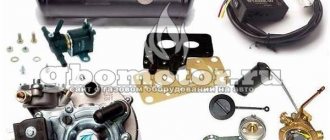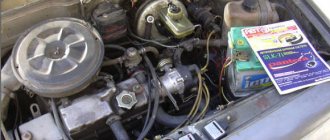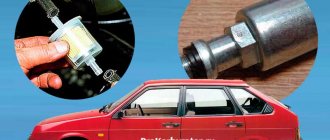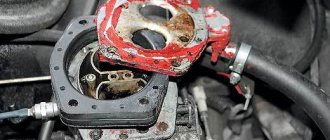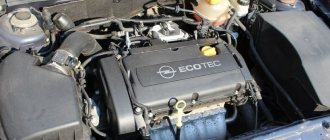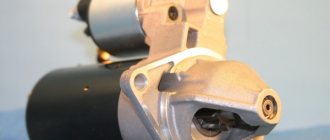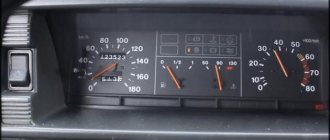The VAZ-2109 model with a carburetor engine is an unpretentious Russian car, characterized by a low price, economical fuel consumption, high maintainability, and very good technical characteristics. However, like any passenger car, it has its own characteristic “diseases”, one of them is that the engine starts and stalls, the carburetor overflows fuel. A similar malfunction occurs in various variants: the engine may stall while driving, the speed decreases when you press the gas pedal (and traction disappears), the engine stops when the car starts moving. Here we will try to consider all the main causes of the problem and the question of how such problems can be solved.
The main reasons for engine stopping while driving or after starting it
There are two main signs when an internal combustion engine (ICE) stalls:
- the motor stops almost immediately after starting (in place, without moving the car);
- the engine turns off (the speed drops to the very minimum) when you try to start moving or switch to a higher load.
The reasons for this behavior of the internal combustion engine are very different and sometimes unexpected; if the engine stalls, barely having time to start, this may be as a result of:
- lack of fuel supply (no gasoline entering the carburetor float chamber);
- somehow the ignition is turned off;
- idle speed disappeared;
- the fuel filter is clogged;
- a partition in the muffler blocked the exit of exhaust gases.
If there is no fuel supply, the fuel pump is most often to blame (on VAZ models 2108, 2109 and 21099 it is of a mechanical type).
To make sure there is fuel supply, you need to remove the central high-voltage wire, disconnect the main fuel pipe from the carburetor and crank it with the starter. If the used pump pumps, gasoline will immediately begin to flow out of the hose; this check should be carried out by two people.
Sometimes a situation arises when a partition inside the muffler blocks the outlet of exhaust gases, the engine “chokes” and does not work. When the exhaust is “half-covered,” the car simply drives poorly – sluggish acceleration, limited maximum speed. When the muffler pipe is completely blocked, the internal combustion engine starts and stalls almost instantly. Checking this version is quite easy:
- one of the diagnostic participants (also needs to be done together) starts the engine;
- the second person observes, placing his palm on the exhaust pipe, whether there is any exhaust of gases.
Another reason for the internal combustion engine to stop is the lack of idle speed in the carburetor; a similar defect is typical for front-wheel drive VAZs. At this point we will dwell in more detail and consider various options for the manifestation of the malfunction and ways to eliminate it.
Engine stalls when switching to gas
The presence of gas equipment in a car, along with certain advantages, can cause a number of inconveniences to the driver. One of the common problems is that the engine stalls when switching from gasoline to gas. The problem can manifest itself in different ways. In the first case, the unit stalls immediately, that is, at the moment of transition; in the second, the engine choke after the driver presses the accelerator after the transition, that is, when the engine is already running on gas in idle mode.
In such a situation, it should be taken into account that the gearbox on many gas equipment requires heating to a certain temperature (for example, 35, 40 or 50 degrees Celsius). To save gasoline during warm-up, some drivers and LPG adjusters set a minimum temperature threshold, after which switching occurs. As a result, a switch to gas occurs, the gearbox is still cold and the engine does not have enough fuel.
The reason is that a cold reducer does not evaporate the supplied gas in the required volume. Please note that we should not exclude the fact that the degree of heating of the gearbox depends on the characteristics of its connection (to the manifold, to the heater hoses, etc.), as well as on the level of coolant in the system. Let us add that another common cause may be the gas injectors themselves. In some cases they need to be cleaned, in others it is better to replace them with more efficient ones.
Problems with idle speed of VAZ models 2108-09-099
VAZ cars of the “ninth” family are equipped with Solex carburetors; they differ in modifications depending on the engine size (1100, 1300 or 1500 cm³). Externally, the carburetor units (CU) are almost completely identical, the difference lies in the internal “filling”: jets of different cross-sections, an accelerator pump nozzle (APA), emulsion tubes, and diffusers are installed. The idle speed system (IDS) in these CUs is responsible for the stability of minimum engine speeds, as well as for fuel consumption.
The Solex XX system includes the following elements:
- channels for supplying fuel and air;
- air jet;
- solenoid valve (EMV) with fuel jet;
- speed screw;
- adjusting needle for the quality of the fuel-air mixture.
The quantity screw sets the position of the throttle valve, leaving it slightly open, and the fuel mixture at low speeds, under the influence of vacuum, enters the engine through the carburetor and passes through the XX channels. Dosing of the mixture is ensured by jets, enrichment or combination is ensured by an adjusting needle, and the fuel supply is controlled using an EMG.
If the solenoid valve does not operate, or the channels are clogged, fuel and air in the required proportions will not flow into the intake manifold, idle speed will disappear. Because of this, various problems occur during the operation of the internal combustion engine:
- the engine starts and stalls because there is no idle speed;
- even if there is XX, the engine still works unstable, and when you try to start moving, it stops;
- the car loses dynamics, and when you press the gas, on the contrary, the car picks up speed.
If, with such signs, you unscrew the EMG a little, the engine will gain speed at idle, but this method will not solve the problem - the car will still not drive normally, and besides, fuel consumption will increase.
Does your VAZ 2109 constantly stall at idle? Everything can be solved - fix it yourself
There may be several reasons that lead to a situation where the VAZ 2109 stalls at idle. The most common ones are a clogged fine fuel filter or jet, as well as a malfunction in the speed control system on the carburetor. All reasons relate to easily repairable breakdowns on your own, in a garage or in a parking lot. The 2109 stalls at idle also due to insufficient time to warm up the engine, but experienced drivers do not have this problem. Therefore, it is worth concentrating efforts to find defects in two directions - checking the patency of the fuel supply line and in setting the carburetor for idle mode. Fuel line Stable operation of the carburetor in idle mode is controlled by a jet. If the nozzle malfunctions, it must be unscrewed and blown out with air under pressure, thereby removing dirt particles. In case of serious blockage, you can resort to flushing with a diluted mixture of gasoline or acetone. On some VAZ 2109 models, jets with a valve that has an electromagnetic control are installed. This valve regulates the flow of fuel into the nozzle. During normal operation, the fuel supply stops when the engine speed exceeds 2100 rpm. The valve opens again when the speed drops to 1900 rpm. It is possible to diagnose its breakdown only with the use of special equipment at a service station. However, there is also a “folk” method of verification. To do this, it is enough to quickly disconnect and connect the power supply wire to the valve while the engine is running. At the moment of such manipulation with the wire in the valve, you can hear a click, which will indicate its good condition. A fine filter for the fuel mixture is installed on the fuel line in front of the pump for supplying gasoline to the carburetor. According to the regulations, it must be replaced with “2109” every 15,000 km, but this is subject to high-quality fuel. Uneven operation of the engine (jerky) at idle and high speeds may indicate that it is clogged. In this case, it must be replaced; purging will probably only be effective if you need to go to a car dealership to buy a new filter. Setting up the carburetor The VAZ 2109 was equipped with a Solex brand carburetor, domestically developed and assembled. To adjust the supply of the fuel mixture to the engine, you will need a screwdriver with a long blade and a portable device for measuring the engine speed. There are two adjusting screws on the carburetor, one is responsible for the quality, and the other screw for the volume of fuel supply. The setting conditions for starting the adjustment procedure are:
- adjusted ignition system;
- engine warmed up to 90°C. (winter 85°C)
Steps for setting up the carburetor:
- the screw responsible for the fuel volume is tightened until the engine stalls;
- for the same screw, make two full turns in the opposite direction and start the engine;
- if the engine does not start, the screw is made one more full turn;
- on the tachometer the number of revolutions should be around the 1020 rpm mark;
- Having achieved the required tachometer reading, you can begin to manipulate the screw responsible for enriching the mixture;
- this screw must be rotated until the speed reaches 850 rpm;
Note: drivers who are not accustomed to long engine warm-ups should set the idle speed to 900 rpm, since the 850 rpm mark is optimal for a well-warm-up engine. The above manipulations with adjusting the carburetor and cleaning the fuel supply line will effective when the engine does not stall at idle regularly.
If there is a constant problem with idle speed, comprehensive diagnostics are required in a service station. AutoFlit.ru
What to do if idle speed disappears
If the car is unstable at idle, drives with dips, or constantly stalls, first of all you need to check the functionality of the solenoid valve. We check it as follows:
- we start the engine at low speed, and to prevent the engine from stalling, use the quality screw to add speed;
- with the internal combustion engine running, without pressing the gas pedal, pull off the EMG wire plug;
- if the nature of the work has not changed, you need to check the presence of power on the EMG; to do this, turn off the engine, turn on the ignition, and bring the chip with the wire to the valve. If there is voltage, a slight click should be heard (to hear it better, you can repeat the test several times).
If there is no power, most likely the economizer control unit has failed, or there is a bad contact somewhere in the wiring (probably a break). This problem needs to be fixed; it is possible that the reason for the absence of XX is hidden here.
But let’s say there is voltage on the valve, but the fault is still present. Now we need to check the operation of the valve itself, we perform this operation like this:
- remove the fuel jet from the EMG;
- We fix the valve body to the ground terminal of the battery, and apply plus to the EMG contact (you can also use it from the battery using a piece of wire);
- when the “plus” is applied, the solenoid valve needle should be retracted (triggered); if this does not happen, then the valve is faulty.
VAZ 21099 carburetor stalls when starting off
With a carburetor VAZ 21099, everything is much simpler. When power dips and power plant failure occur during acceleration or starting off. There are only two possible reasons:
- The mixture is too rich.
- The mixture becomes very lean.
- There are interruptions in the ignition system.
Debugg
Initially, it is worth checking how fuel enters the system. The machine diagnostic sequence is as follows:
- inspect and clean the carburetor strainer;
- in case of severe contamination, replace fine filters;
- perform fuel pump diagnostics;
- check the tightness of all lines, hoses and gaskets;
If gasoline flows into the carburetor without interruption, you need to check its calibration, the fuel level in the float chamber and thoroughly rinse the internal channels and jets in order to eliminate possible blockages.
In parallel with diagnosing the fuel system, you should check the correct installation of the ignition angle, spark plugs, wire armor, serviceability of the distributor and ignition coil. It is also worth paying attention to the hall sensor. And also clean or replace the air filter.
Effect of air leaks in the fuel system
Unstable operation of the internal combustion engine, failures during acceleration of the car can also occur due to air leaks in the fuel system (TS), because as a result of the appearance of excess air mass, the proportion of the mixture necessary for the complete combustion of gasoline in the cylinders is disrupted. Air suction can occur:
- between the top cover and the main body of the carburetor due to metal deformation;
- due to a loose fit of the lower platform of the HRSG to the intake manifold;
- as a result of a rupture of the hose or its poor connection with the fittings of the vacuum brake booster (VUT);
- due to a malfunction of the vacuum booster itself.
It is quite easy to check whether VUT affects the stability of the engine; you need to disconnect the “vacuum” hose from the intake manifold, plug the fitting, and start the engine.
If, after installing the plug on the fitting, the engine operation is leveled out and it no longer “trips”, we have correctly identified the cause of the malfunction. Sure signs of leakage in such cases: a noticeable hiss of air in the area of the “vacuum chamber”, engine stopping or a sharp drop in speed after pressing the brake pedal. The power mode economizer (EMR) also affects the stability of the idle speed; more precisely, its diaphragm, if it is broken, the engine will not work normally at low speed. In any case, it is worth checking the condition of this part; you can remove the diaphragm without dismantling the carburetor (unscrew 3 screws).
The engine choke when you press the gas VAZ 2109 carburetor
A fairly common situation during the operation of a vehicle is when failures occur when pressing the gas pedal, the engine stalls when over-accelerating, the power unit does not pick up speed, choke, etc.
We also recommend reading the article about why the engine does not pick up speed. From this article you will learn about the reasons why the power unit responds to pressing the gas pedal with a delay or does not develop power.
Let's start with the fact that there can be many possible reasons for this type of malfunction. In the process of initial diagnosis, an important condition is the observation of characteristic symptoms, which allows you to more accurately and quickly determine the malfunction. Next, we will look at why the engine stalls when you press the gas pedal, as well as in what cases the engine stalls when you press the gas.
The engine stalls when you press the gas: possible reasons
As already mentioned, certain signs allow you to localize the existing problem. For example, if the engine stalls when “cold” after pressing the gas pedal only when the humidity outside is high, moisture may well be the cause.
- The problem is that water particles can accumulate on the distributor cap. Such accumulations of moisture settle on the inner surface of the lid in the form of condensation. Let us add that on some cars the cover is shaped in such a way that allows current to pass through the distributor, that is, the discharge is simply not supplied to the spark plugs. At the same time, at idle, the internal combustion engine operates normally, but when you press the gas, the problem manifests itself. This is explained by the fact that the distributor, at the moment of gas supply, begins to operate in an accelerated mode, passing a larger amount of electricity. Taking into account the fact that moisture has accumulated in the distributor housing, a malfunction immediately occurs and the engine choke, as a weak spark is formed at the spark plugs. To check, it is enough to observe whether such a failure is present on a warm engine, and also whether the malfunction appears when it is dry outside. You can also put the car in a heated garage or parking lot for several hours, and then evaluate the stability of the internal combustion engine after starting and at the moment you press the gas.
- Another reason why the unit may choke is that there is no vacuum in the fuel system. In other words, air leakage occurs, which affects the fuel pressure and the composition of the fuel-air mixture. Usually the problem progresses gradually and can occur on both a cold and hot engine. The fact is that in order to accurately determine the amount of fuel supplied at a specific point in time, the vacuum in the fuel system plays an important role.
- An additional sign of problems with the fuel system is a glowing “check” on the dashboard. In this case, it is recommended to carry out computer diagnostics of the engine to read the error code. Let us add that quite often engine failures after pressing the accelerator can also occur as a result of problems in the EGR exhaust gas recirculation system.
- If the engine constantly stalls when you press the gas pedal, then the throttle position sensor (TPS) deserves special attention. The purpose of the element is to determine at what angle the throttle valve is open and further transmit data to the controller. Failure of this sensor means that the engine ECU is receiving incorrect data. As a result, the system is unable to accurately determine how much fuel needs to be supplied to the cylinders during injection through the injectors. In other words, the control unit may either not initiate injection at all, or supply an inappropriate amount of fuel. In such a situation, the “check” may also light up on the dashboard. Another thing on the list of reasons that affect the ECM is also possible failure of the mass flow sensor or malfunctions in its operation. If problems arise with the DPKV, then malfunctions in the operation of this sensor may cause the engine to completely stop when trying to press the gas.
- We also recommend reading the article about what DPKV is. From this article you will learn about the purpose and operating features of the specified sensor of the electronic engine control system.
- During diagnostics, it is necessary to exclude the possibility that the injection nozzles are “pouring” fuel, supplying the engine with a too “rich” mixture. Such enrichment can lead to the fact that after pressing the gas, the cylinders are filled with fuel and the engine stalls.
- Spark plugs and/or high-voltage wires also deserve special attention. If these elements turn out to be faulty, then this affects the quality of sparking. The problem may also lie in other elements of the ignition system. When you press the gas, the engine may not have enough spark to properly ignite the fuel charge in the combustion chamber. The result is failures and the engine choke. At the same time, it should be taken into account that the ignition timing can also affect the stability of the internal combustion engine. In some cases, if the OZ is incorrectly set, the engine stalls after pressing the gas.
- During the diagnostic process, you should also check the condition of the fuel and air filters. If the filter elements become clogged, this may affect the composition of the air-fuel mixture. As a result, insufficient air or fuel supply leads to the fact that the moment you press the gas pedal, the engine may choke or stall. This also includes the strainer on the fuel pump. If this element is heavily clogged, then when you press the gas, the pump is not able to supply fuel to the injectors in the required volume. For verification, it is necessary to measure the pressure in the fuel rail, which allows you to evaluate the performance of the fuel pump.
- The final element on this list that can fail is the ECU itself. If the engine control unit fails for any reason, then the synchronous operation of the power supply, ignition and other systems will be disrupted even with fully functional sensors. It turns out that after starting the internal combustion engine and idling the unit, the control unit is not able to make a normal transition to operating mode under load after pressing the gas pedal.
Engine stalls when switching to gas
The presence of gas equipment in a car, along with certain advantages, can cause a number of inconveniences to the driver. One of the common problems is that the engine stalls when switching from gasoline to gas. The problem can manifest itself in different ways. In the first case, the unit stalls immediately, that is, at the moment of transition; in the second, the engine choke after the driver presses the accelerator after the transition, that is, when the engine is already running on gas in idle mode.
In such a situation, it should be taken into account that the gearbox on many gas equipment requires heating to a certain temperature (for example, 35, 40 or 50 degrees Celsius). To save gasoline during warm-up, some drivers and LPG adjusters set a minimum temperature threshold, after which switching occurs. As a result, a switch to gas occurs, the gearbox is still cold and the engine does not have enough fuel.
The reason is that a cold reducer does not evaporate the supplied gas in the required volume. Please note that we should not exclude the fact that the degree of heating of the gearbox depends on the characteristics of its connection (to the manifold, to the heater hoses, etc.), as well as on the level of coolant in the system. Let us add that another common cause may be the gas injectors themselves. In some cases they need to be cleaned, in others it is better to replace them with more efficient ones.
What's the result?
If the engine choke when you press the gas, you should start by checking the spark plugs. Very often, a problem with an engine is solved by simply installing new spark plugs. Please note that when the check light comes on on the dashboard, this is the basis for computer diagnostics of the engine. The specified diagnostics in many cases allows you to narrow down the scope of troubleshooting as much as possible and quickly eliminate the breakdown.
Finally, I would like to add that if the engine begins to choke after cleaning the throttle valve, then this element should be additionally calibrated. We are talking about training the throttle valve after cleaning. Ignoring calibration can lead to the fact that at idle the speed may float or be too high, and the engine may choke after pressing the accelerator pedal.
The influence of the accelerator pump on the operation of the VAZ-2109 internal combustion engine
Unstable engine operation, stalls, sluggish acceleration, etc. can also occur due to malfunctions in the Solex accelerator pump system. Here are the main causes of problems on the “nine”:
- incorrect dosage of the sprayer (“spout” or “elephant”), as well as clogging of this channel;
- torn or dried out diaphragm;
- incorrectly selected accelerator pump drive (“flag”).
Factory nozzles for the “nine” usually have two “spouts”, which are distributed among the chambers, but in the “secondary” fuel injection turns out to be completely unnecessary, at least that’s what many craftsmen think. The modernization of this part is the transfer of both “spouts” to the “primary chamber” (primary chamber), another option is the installation of a single sprayer from the KU for the Niva.
When bending the tubes, it is important to install them so that the injection passes exactly between the carburetor body and the damper, without hitting these parts, otherwise there will be no effect from such tuning.
The injection is checked, of course, with the carburetor removed, without the top cover, with the float chamber filled with gasoline. When you open the throttle (simulating pressing the gas pedal), you should get two even jets that pass through the lower part of the body without hitting it.
Carburetor power units are actually a thing of the past. But many cars on the roads of our country still use this option for supplying fuel to the engine. For many, a carburetor turns out to be a fairly convenient means of replacing an injector, since the car becomes easier to repair and cheaper to operate. In most cases, the owner of a carburetor car can independently carry out basic maintenance work on the fuel supply system. In the case of an injector, this task should only be performed by specialists. For simple carburetor repairs, you do not need special equipment, but to work with an injector, such devices are simply necessary. Therefore, such a part of the engine power system has certain advantages. Interestingly, these advantages force many to change the injector to a carburetor, which is not difficult at all.
Problems that arise with the carburetor can be very different. One of the common problems is that the engine stops working after the car has completely warmed up. The driver has to increase the speed with the help of a choke, but this trick will not work on carburetors with auto-choke. Eventually, the engine will stall as soon as you release the gas pedal. At every traffic light, intersection and pedestrian crossing, the driver begins to curse fate, red lights and innocent pedestrians, and the carburetor continues to stall and refuses to work normally, despite very expensive gasoline. Let's figure out the nature of this trouble.
Failure when sharply pressing the gas pedal VAZ 2109 carburetor
If a failure occurs when you press the gas pedal of a VAZ 2109 carburetor, this is a common thing. The car is domestic, and has been in active use for many years, so you shouldn’t be particularly surprised. We need to calmly see what can be done.
Failure when sharply pressing the gas pedal VAZ 2109 carburetor
Carburetor or injector
While the whole world has made a choice in favor of injection engines, in our country the intensity of the debate on the topic “injector or carburetor” does not subside. Mostly, the debate revolves around the possibility of field repair of an engine with a carburetor or an injector. Adherents of the first passionately prove that a failed carburetor engine can be easily repaired literally “in the open field.” And if the injection engine fails, prepare a tow rope and go to the service center.
Proponents of injectors raise the objection that injection engines break down much less often, and there are only two typical malfunctions.
- Damage to the crankshaft position sensor.
- Fuel pump failure.
At the same time, the “injection guys” rather sarcastically clarify that the fuel pump can just as easily break down on a carburetor engine, and the sensor costs a penny and can be easily changed even in the field. Perhaps we should admit that the supporters of injection are somewhat right. But if you happen to drive a carburetor version, then you shouldn’t chase the illusory savings of a glass of gasoline per 100 kilometers. You shouldn’t start switching to a new type of power system just because the VAZ 2109 carburetor failed when you pressed the gas pedal.
If something happens, the carburetor “nine”, even if it sneezes in blue puffs, even with a sinking accelerator pedal, will take you home - after all, it’s worth something.
Ozone or Solex
With the start of production of the VAZ 2108 and 2109, AvtoVAZ designers abandoned the use of Ozone carburetors, in which many complex options had no practical meaning. What was the cost of the forced idle economizer alone, which supposedly served to save fuel during engine braking? Neither engine braking became widespread, nor did the EPKH bring any noticeable savings, but it provided drivers with quite a few headaches when pressing the gas.
When switching to “eights” and “nines”, the plant returned to a simpler version of the carburetor. It was distributed under the name Solex: after the name of the French company that produced its prototype. Solex lost the pneumatic drive for the secondary chamber damper, a semi-automatic starting device, and an autonomous idle system.
The design has been simplified and reliability has increased. It is Solex that, as a rule, owners of carburetor versions of the VAZ 2109 deal with.
Non-carburetor causes of engine failure
Car owners usually refer to failures as unpredictable short-term interruptions in the operation of a car’s internal combustion engine. Failures belong to the category of so-called “unreasonable”, or, more precisely, multi-cause failures. It is impossible to say unequivocally about such breakdowns: failures appear - change the spark plugs. More precisely, it is possible to say, but it is not a fact that after replacement the failures will disappear. Although this also happens.
So failures in the operation of a carburetor engine are not necessarily related to the device itself. And before you start working on such a complex unit, you should exclude the influence of other reasons.
- Mechanical failure of the drive.
- Ignition system malfunctions.
- Failures of the power system located outside the carburetor.
These groups of negative factors stand out among others. Let's look at them in detail.
| Malfunctions | Your actions |
| Mechanical failures of the drive include, first of all, a faulty throttle cable. | It simply needs to be replaced. |
| In the ignition system, spark plugs most often fail. | Excessive carbon must be cleaned, faulty spark plugs must be replaced. |
| High-voltage wires fail a little less often. | It is not recommended to check the spark “to ground”; this is dangerous. You should measure the resistance of the wires using an ohmmeter and make sure that it corresponds to the nominal value. |
| Excessive wear of the carbon contact in the distributor cover. | Rule out this reason. |
| If everything is in order with the ignition system, and the engine still fails when you press the pedal sharply, move on to the power system. | Most often the fuel pump fails. Start with an inspection of this particular unit. |
Remove the outlet pipe from the fitting. Press the fuel pump manual drive lever vigorously. There should be an intense stream of fuel coming out of the hose. If not, the pump is faulty and must be repaired or replaced. Clean the fuel line filters from the tank to the carburetor, and blow out the pipelines themselves.
If everything is in order with the power and ignition systems, move on to the carburetor itself.
VAZ 2109 carburetor malfunctions
A significant volume of fuel with all impurities, chemical and mechanical inclusions, conceivable and inconceivable contaminants passes through the carburetor. This means that cleaning will never harm the carburetor. It is about total cleaning that we will talk about.
Everything is cleaned, including fuel injectors, air jets, transition channels, filter elements and metering wells. This is done like this:
- disconnect the mechanical throttle actuator;
- separate the inlet and outlet fuel pipes;
- wrap the freed carburetor with aluminum foil of sufficient width;
- place the wrapped carburetor in a plastic bucket to protect it from leaking;
- fill the carburetor with acetone or other strong solvent;
- leave the carburetor in a flooded state for a day.
Keep in mind that this should be done in a well-ventilated non-residential area. At the end of washing, drain the solvent, rinse the unit with a running stream of solvent, blow with a stream of compressed air, and dry. Install the carburetor in its original place. Try your "nine".
If a radical flush solves the problem, ride to your heart's content. If you haven’t decided, it’s time to turn to professionals. Forget about engine failures for a while and go to a car service center.
Why might the carburetor stall after warming up?
To understand the cause of this problem, it is best to contact motorists who have already encountered such a problem. Whatever happens to your car, remember that similar problems have most likely happened to other car owners. Therefore, you should visit specialized forums or simply chat with other motorists. In this case, you can find several options for answering your question. After warming up, the carburetor completely closes the choke valve, leaving the accelerator valve in working condition. If the idle speed is set incorrectly, the engine will only run on choke. But this is the basic reason; there are several other popular problems:
- rapid engine overheating and serious problems with the cooling system of your power unit;
- very poorly adjusted valves - adjustment has not been made for several years in a row;
- the carburetor is not adjusted, the mixture is too lean, the system blows too much air into the combustion chamber;
- the mixture can also be overly rich, which causes fuel overflow and problems in some carburetors;
- the carburetor jets are clogged, fuel flows poorly through them, which causes problems in the quality of the mixture;
- gasoline is incredibly bad, the filters are clogged, the flow rate of the fuel system has become much lower;
- Certain problems have arisen inside the carburetor, membranes and gaskets have broken, and fuel is leaking.
Malfunctions in the exhaust manifold
The engine only works correctly if it is completely sealed. Various gaskets are responsible for the tightness, and if any of them is destroyed, then there can be no question of tightness. This violation leads to the fact that the preparation of the fuel mixture occurs with irregularities. For example, if the cylinder gasket is damaged, coolant will leak into the fuel tank.
To eliminate problems of this type, you simply need to replace the damaged gasket. These manipulations can be done independently, but if more serious problems arise, it is best to contact a specialist.
An exhaust manifold
The moment when the engine suddenly stalls when you press the gas is extremely unpleasant and often takes the driver by surprise. It is unlikely that it will be possible to quickly understand the reason for this behavior of the vehicle. It is necessary to carry out a fairly thorough inspection and then make the necessary repairs. Driving a disabled car is strictly prohibited.
We carry out diagnostics and repair work on the carburetor ourselves
You can take advantage of excellent carburetor work if you know its design and have already dealt with simple repair processes. Otherwise, we do not recommend that you try recovery on your own. Ultimately, such repairs will cost much more than they could cost from specialists. If you have experience and confidence in your skills, you can use the advice of specialists to perform a high-quality restoration of your car. Among the main work that will have to be carried out, the following processes can be identified:
- remove the carburetor cover with the air filter and try to start the car, as it warms up, lower the choke and look at the position of the dampers, perhaps adjusting them will be enough to restore the car’s operation;
- if this does not help, look at the functioning of the fuel system; perhaps the fuel pump stops pumping fuel after a certain period of normal operation;
- also examine the cooling system, regardless of what the gauges on the dashboard say, look at the antifreeze level, make sure the thermostat is working correctly;
- you can also change the air and fuel filters to make sure that fuel and air enter the carburetor without problems and in sufficient quantities;
- the last stage of work is the removal and disassembly of the carburetor to install a repair kit, new gaskets, membranes and other parts, as well as to clean this device from contamination.
You can think for a long time about what the problem really is, or you can simply go to an automotive supply store, buy a carburetor repair kit that is installed under the hood of your car, carry out the necessary work and get the cleanest operation of the power unit. This is the only way you can get high-quality operation of the equipment and no problems with the power unit. After diagnostics and corrective work, the carburetor will definitely stop tormenting you with constant stoppage of operation. This will allow you to operate the car efficiently and safely.
Unstable operation of the carburetor engine
The nature of instability of engine speed of a VAZ2107/2105 with carburetors is the same as that of an injection engine, in the uncontrolled supply of air or fuel into the combustion chamber.
But in this case, the carburetor is responsible for preparing the combustible mixture. This is a completely mechanical device responsible for the optimal ratio of fuel and oxygen for various operating modes of the power unit.
Although there are filters on the air intakes and fuel filters, they can typically operate ineffectively due to long service life beyond that specified in maintenance standards. As a result, small particles clog the carburetor jets.
Drivers with great experience do not spend much ceremony, throw the VAZ 2107/2105 carburetor into a bucket of gasoline for a day, then blow it out from all sides with compressed air, and the carburetor seems to work normally. This solution is questionable if the carburetor is very dirty.
Among the causes of engine malfunction caused by carburetor failure are:
- displacement of the position of the adjusting screws by shock or vibration;
- increase in nozzle diameter due to wear;
- failure of the float seal.
- clogging of jets;
- wear of the shock absorber axis, limiting its stroke;
To determine the malfunction of the VAZ 2107/2105 carburetor, and it will probably be complex, start by checking the float for leaks. To do this, remove it from the top cover of the carburetor (it must be disassembled). If there is gasoline in the float, throw it away; if there is air, make sure there are no bubbles in the bowl of water. Let's say he passed the exam, then he needs to check the gap.
Lift the carburetor cover to the vertical position. The distance between the float chamber and the carburetor wall should be 6.5 mm.
Install the carburetor cap and run the engine for 30 seconds. Remove the cover. The fuel level should be exactly in the center of the conical surface of the carburetor body. If this doesn't work, you should bend the corner of the float rod a little.
Over time, air and fuel jets become clogged or worn out. In the first case, they need to be cleaned and purged. In the second case, it is necessary to control the flow of the nozzles using a water tank installed above the nozzle, measured at 1 meter. They are connected by a pipe. A volumetric flask is installed at the bottom. Measurements are made in cm3/min. Depending on the marking of the nozzle, the volume of liquid collected per minute in the volumetric flask must correspond.
it is much easier to buy a set of jets and replace them after 7-10 years of carburetor operation.
Those who use gas systems should be aware that the carburetor is not used when driving on gas. Over time, oxide builds up inside dry injectors and clogs the fuel supply ports. A gasoline car may not start. It is recommended to use gasoline periodically.
Carburetor repair by specialists is the best solution
If you have a carbureted car, it would be best to find a professional who can service the equipment regularly. Your car will require high-quality maintenance on a regular basis, since the carburetor is constantly becoming clogged and presents more and more problems in operation. Therefore, it would be best to use the services of a specialist who knows his business very well and performs cleaning, regular maintenance and repair of carburetors, as well as all related equipment. The main criteria for choosing a specialist are as follows:
- experience in working with your car model, sufficient professionalism, confirmed by years of work;
- positive reviews from other owners of carburetor cars who received quality service;
- affordable prices - you don’t have to choose an expensive service station, you can cooperate with a private master;
- fairly quick completion of all necessary repair work, but the presence of a guarantee of the quality of the result;
- the possibility of ordering complex work with the purchase of spare parts performed by a specialist in order to relieve oneself of responsibility for the quality of parts;
- other convenient services, as well as the possibility of full vehicle maintenance.
It is convenient when all repairs and maintenance are carried out by one person. This makes it quite easy to get a high-quality working car, since one person or one company is responsible for it. If one person repairs your carburetor, another person maintains the car, and a third person solves problems with the generator, all this is not very convenient for repair work on the car. So it’s better to find a universal specialist and constantly service the car exclusively from him. If you have a Solex carburetor installed on your car, we suggest watching a video about its disassembly and maintenance:
Other reasons for incorrect starting of the VAZ 2107 engine
Another common problem that causes the engine of VAZ 2107 cars to start and stop is excess air getting into the carburetor. In this case, the fuel mixture cannot keep the engine running for a long time, and although the car starts, it stalls after a few seconds. It is necessary to determine the location of the air leak and eliminate the gap.
It happens that the injectors and nozzles of the dosing system become clogged. This also affects the reduction in engine speed, so that the VAZ 2107 stops after a few seconds. What to do in this case? It is necessary to unscrew the jets and pipes under the carburetor cover and clean them. Next, blow out the wells and nozzles with compressed air. If you have a Solex carburetor, you will also need to clean and bleed the fuel jets located at the bottom of the wells.
Let's sum it up
Fine cars with carburetor engines have become industrial history, but they are still widely represented on the roads. That is why you can use the ideas presented in this publication, since there are still a lot of carburetor masters, and you can find the necessary spare parts in stores. If your car has problems with the quality of the fuel supply system, it’s time to fix all these problems. You can quite easily obtain high quality operation of the power unit and fuel system if you simply take care of all the important components of the car.
For the carburetor to work properly, it simply needs to be cleaned occasionally. This point is quite important for every car operating in Russia. Fuel quality, atmospheric pollution - all this affects the normal operation of the engine. It is enough to carry out a high-quality cleaning of the fuel supply system every few years by performing certain maintenance processes to ensure long-term and high-quality operation of all engine systems. How did you maintain a carburetor car?
Problems with the power system
Another reason when the engine stalls when you press the gas may be incorrect operation of the power system. Completely different things can cause such violations, but most often it is low-quality fuel. Various impurities that are added to such a surrogate can lead to blockages in various components of the power system, namely filters, injectors, etc. Provided that the blockages are not severe, failures in engine operation will be quite rare. As the blockages increase, there may come a time when starting the engine becomes simply impossible. Determining the presence of this particular reason is quite simple:
- Checking the pump. The first thing you need to do if you have any suspicions is to evaluate the operation of the pump. To do this, you will need to remove the pump and check whether the liquid flows unhindered. If problems are found, you will have to disassemble the part body and clean the filter diaphragm.
- Injectors. If the pump is in good condition, you will need to flush the injectors. This procedure is usually performed in specialized centers using ultrasound.
To prevent these problems from arising in the future, it is necessary to be more careful when choosing gas stations.
Another reason for the engine stalling when you press the gas pedal may be poor ventilation in the fuel tank. This can happen if the drain tube is clogged. This problem is very easy to identify. You just need to open the gas tank and start the engine. If the engine stops stalling, then simply clean the drainage.


